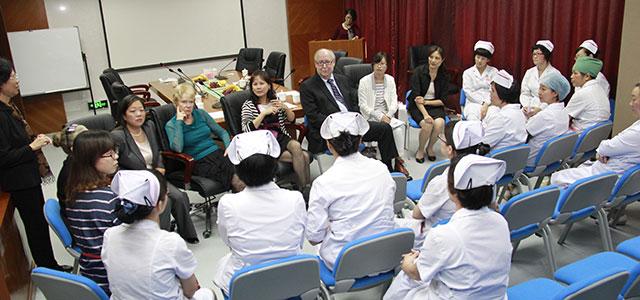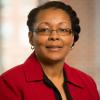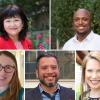
UC San Francisco School of Nursing faculty meet with nursing leaders at Shantou University Medical College Affiliated Cancer Hospital.
UCSF Faculty Trip Forges Relationships to Build Nursing Workforce in China
With 1.3 billion people and a demographic shift to an older, more urban population, China needs more nurses. In November 2013, Dean David Vlahov and four faculty members from UC San Francisco School of Nursing – Sally Rankin, Angel Chen, Jyu-Lin Chen and Mary Louise Fleming – traveled to China on a fact-finding mission. The goal was to explore how the School might collaborate with Chinese nursing schools and organizations to help build nursing capacity and enhance expertise to meet the increasing health care needs of a country undergoing significant change.
A New Nursing Program in Shantou
The group’s first stop was in Hong Kong (see below), before it moved on to Shantou, in Guangdong Province, where they toured five affiliated medical centers and met with faculty and students from Shantou University Medical College and with representatives from the Li Ka Shing Foundation. Among the potential projects they discussed was an exchange that would allow several Chinese nursing students and hospital-based nurses to come to UCSF as “special studies students” – to observe how things are done in different clinical settings and in the classroom.
While Shantou University Medical College has been training nurses for years, they recently created a four-year baccalaureate program in nursing with support from the Li Ka Shing Foundation, with the goal of building a highly educated and qualified nursing workforce.
“It’s an ambitious undertaking to make [the nursing program] a global leader in nursing education,” says Vlahov. To that end, the program strives to attract the most highly qualified applicants. Applicants must score above the national mean on their National Higher Education Entrance Examinations, which would also qualify them for highly competitive programs in other scientific fields, such as medicine or engineering. Once enrolled, the program’s nursing students are required to study English, which will give them access to a wider repository of research and evidence – and help prepare them for work in the global health community.
The drive to attract the best and the brightest seems to be working, says Rankin. “The students were very impressive, very committed. I have no doubt that they’ll be leaders of Chinese nursing in the future.”
Building on Existing Relationships in Hong Kong and Shanghai
 The Chinese University of Hong Kong While the visit to Shantou helped forge a new partnership, the Hong Kong leg helped re-energize existing relationships with nursing programs at The Hong Kong Polytechnic University and The Chinese University of Hong Kong. At both these universities, Vlahov and the team met with faculty to identify potential future collaborations for faculty development and research, particularly in areas where there is mutual interest and expertise, such as symptom science and aging.
The Chinese University of Hong Kong While the visit to Shantou helped forge a new partnership, the Hong Kong leg helped re-energize existing relationships with nursing programs at The Hong Kong Polytechnic University and The Chinese University of Hong Kong. At both these universities, Vlahov and the team met with faculty to identify potential future collaborations for faculty development and research, particularly in areas where there is mutual interest and expertise, such as symptom science and aging.
Among the overarching goals related to increasing health care workforce capacity in China, says Rankin, is to create a larger workforce of nurse researchers. Because this will require broader access to advanced education for more nurses, Rankin, Fleming and Jyu-Lin Chen made a final stop at Fudan University in Shanghai – which includes a well-known and respected school of nursing – to discuss with faculty there the possibility of expanding access to doctoral programs in nursing for Chinese students.
Enhancing Nursing Knowledge Across Cultures
Although the trip’s focus was on expanding nursing capacity in China, the benefits of collaboration go two ways, says Vlahov. Among the things that impressed him at the Chinese facilities, he says, was their commitment to palliative care. The School is currently developing a palliative care minor, so there’s potential for sharing expertise between the two cultures.
“I see it as developing a knowledge network,” Vlahov says.
Rankin notes the integration of techniques that are considered alternative in the US but are part of standard care in China, such as acupuncture and herbal medicine. “When they send some of their nurses here, I hope they can spread some of that knowledge,” she says. “You can’t help but learn from the people who come here.”
Observing other cultures and ways of doing things is a way of providing context to the things we do on a daily basis and improving one’s own practices, Vlahov says. “You can do better in your own setting if you’ve seen people in other settings on which to base comparisons.”



